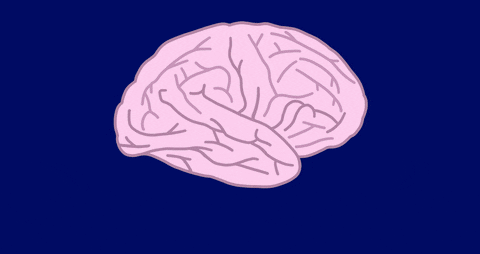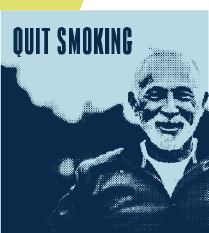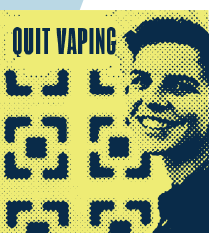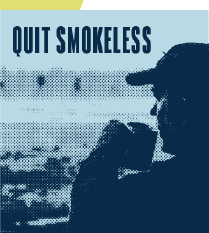Decide Guide
What to expect when Quitting
We won’t kid you—it may be hard. But people do it every day, so it is possible. People tell us how proud they are to accomplish something so major in their lives and that the difficulty was worth it. This guide will help you learn more about what to expect and decide if quitting right now is good for you.

COMMON QUESTIONS WHEN DECIDING WHETHER TO QUIT
What will I do without cigarettes, vapes or smokeless tobacco?
+
It’s true, they won’t be there when you quit. Using new ways to cope with stress, restlessness, boredom, and other trigger situations is the key. Find something fulfilling to do, such as a hobby you enjoy, to help ease you into your new lifestyle.
Do people gain a lot of weight when they quit?
+
The average weight gain is 10 lbs after quitting smoking. People who quit vapes or smokeless tobacco could have similar gains. However, you can prevent this. Make a plan to replace your tobacco use with an activity (take a walk, plant some flowers, start a new hobby). Also, stock up on healthy snacks or gum prior to quitting.
The last time I quit I was not nice to be around. How do I avoid that?
+
Quitting may make you irritable—many people get moody when they aren’t getting what they want. With a good plan, including an active routine, you’ll be prepared to manage bad moods. As with most withdrawal symptoms, by the end of the first week or two you should be feeling less and less irritated
Can I just use less and eventually quit?
+
Depending on what you want for yourself and for the people around you, this can be a good step. Many people don’t smoke or vape in their homes because they’re concerned about others. This concern can be a strong motivator. Plus, you can increase your chance of quitting by cutting down, especially when you have set a quit date OR especially when you are working toward a quit date.
Is there something I can just take that will make me quit?
+
No. There is no “magic bullet.” Your motivation, combined with solid planning, is what will carry you through. Later on we will explore some options that could make quitting easier for you. But, there is really only one thing that will “make” you quit: you.
What can I expect after I quit?

Withdrawals

Stress

Cravings

Good & Bad Days

Self-Respect

Freedom

Breathing easier

Praise

Accomplishment
Health Risks
Parts of the body affected by tobacco use
WHAT’S IN CIGARETTES, VAPES & SMOKELESS TOBACCO?
There are about 600 ingredients in cigarettes. When burned, they create 7,000+ chemicals. Ingredients vary across vape devices and smokeless tobacco, however, many contain toxic chemicals and metals.
| Chemical | Found In | Cigarettes | Vapes | Chew |
|---|---|---|---|---|
| Acetone | nail polish remover | X | ||
| Acetic acid | hair dye | X | ||
| Acrolein | powerful irritant linked to lung & heart disease | X | X | |
| Ammonia | home cleaners | X | ||
| Arsenic | rat poison | X | X | |
| Benzene | rubber cement | X | X | |
| Butane | lighter fluid | X | ||
| Cadmium | batteries | X | X | X |
| Carbon monoxide | car exhaust | X | ||
| Hydrogen Cyanide | poison | X | ||
| Diacetyl | chemical flavoring linked to serious lung disease | X | ||
| Diethylene glycol | antifreeze, brake fluid, some dyes | X | ||
| Formaldehyde | embalming fluid | X | X | |
| Hexamine | lighter fluid | X | ||
| Lead-20 | household paint | X | X | X |
| Naphthalene | mothballs | X | ||
| Methanol | rocket fuel | X | ||
| Nitrosamines | found in some drugs to treat blood pressure | X | ||
| Propylene glycol | synthetic food additive | X | ||
| Polonium-210 | radioactive element | X | X | |
| Nicotine | addictive chemical | X | X | X |
| Tar | road paving | X | X | |
| Toluene | crude oil, paints, lacquers, explosives, glues | X |
Most people know cigarettes, vapes & smokeless tobacco are harmful, but don’t know exactly what’s at risk.
Smoking
Smoking can cause serious health problems like cancer, heart disease, lung disease, and stroke.
Things in tobacco smoke that cause damage:¹
• Nicotine: Narrows blood vessels, speeds heart rate, and makes blood thicker, which can cause clotting
• Carbon monoxide: Cuts oxygen flow to the heart, brain, and other tissues
• Tars: Solids that can irritate and damage organs
Other health concerns
• Cough and phlegm: Coughing and breathing problems from mucus build-up
• Fertility: Decreased fertility in women and men
• Impotence: Not able to get or maintain an erection (erectile dysfunction)
• Healing: Wounds take longer to heal
• Immune system: Harder to fight sickness
Vaping
Scientists are still learning about the long-term health effects of vapes. Here is what we know now. Source: CDC.gov
Vapes are not safe for youth, young adults or pregnant women. Vape aerosol that users breath from the device and exhale can contain harmful substances including:
• Ultrafine particles that can be inhaled deep into the lungs
• Flavoring such as diacetyl, a chemical linked to a serious lung disease
• Volatile organic compounds
• Cancer-causing chemicals
• Heavy metals such as nickel, tin, and lead
Chew
Chew contains at least 28 chemicals that can cause the following health problems:
• Cancer of the mouth, tongue, cheek, gum, throat and pancreas.
• Mouth Lesions. About 3 out of 4 daily smokeless tobacco users have leukoplakia, white patches in the mouth that can cause cancer.
• Heart Disease. Nicotine in chew can make heart rate and blood pressure go up, which can lead to heart disease.
• Gum Disease. Even with regular dental care, chew can cause tooth loss, receding gums, stained teeth and bad breath.
• Cavities. Chew contains a lot of sugar that can weaken teeth and cause cavities.
Health Risks for those Around You
Tobacco smoke, vape aerosol, and smokeless tobacco all contain chemicals that are harmful to pregnant women and young children. There is no risk-free level of secondhand exposure to these products.
Tobacco Smoke
Over half of California’s kids are exposed to secondhand tobacco smoke, which contains about 70 cancer-causing chemicals. 1
If you smoke around infants and young children, the risks go up for:
- SIDS (Sudden Infant Death Syndrome) – infants are three times more likely to die of SIDS if born into a house with smokers.
- Illness – secondhand smoke can cause ear infections, asthma, pneumonia, and bronchitis.
- Learning problems
If you smoke when pregnant, the risks go up for:
- Preterm labor – can cause baby to be born early and too small
- Low birth weight – baby is born less than 5 lbs 8 oz and can have trouble with eating, gaining weight, and fighting off illness
- Less oxygen – slows growth and harms the heart, lungs, and brain
- Placenta issues – baby can’t get enough food to grow
- Birth defects – can include a cleft lip or palate
- Miscarriage – pregnancy loss before 20 weeks
- Stillbirth – pregnancy loss after 20 weeks
Vapor or Aerosol
Vaping is on the rise, especially among youth. The U.S. Surgeon General states that while vapes generally emit fewer toxic chemicals than cigarettes, the aerosol that is emitted from these devices is not just water vapor. Most is a mixture of nicotine, tiny particles of heavy metals, and chemicals. Vape aerosol, like cigarette smoke, contains ultrafine particles, which settle deeply into the lungs when inhaled by people using it or near it.2
Vapes contain e-liquid that comes in thousands of flavors, many of which appeal to kids, like bubble gum and grape. These sweet flavors may tempt kids to drink the e-liquid or put vapes in their mouth.
Nicotine Addiction & Dependency
Let’s take a look at why it’s so tough to kick the habit.
When you smoke or vape, nicotine enters the bloodstream and reaches the brain within seconds. Nicotine causes a release of “feel good” chemicals in the brain called neurotransmitters.
The problem is, after repeated nicotine use, the brain becomes used to the increase in neurotransmitters. This is when you start to use nicotine just to feel normal.
When you take nicotine away, the brain doesn’t get the neurotransmitter activity it’s used to getting. This causes discomfort. For some people it results in irritability, sadness, depression, and other withdrawal symptoms.
Just as the brain learns to respond to nicotine, it can learn to respond to different cues—it can learn other ways to make you feel good without addiction and dependency. For some, this means eating healthy meals, meditating, listening to music, or getting more physically active. What will it mean for you?
Motivation to Quit
MOTIVATION: FIVE THINGS TO THINK ABOUT
Check Your Motivation: Make a Pros & Cons List
Identify your reasons to use and your reasons to quit. Looking at both sides and writing down reasons for each will allow you to see which way you’re leaning.
It’s not how many reasons there are, but how meaningful those reasons are to you. You can decide whether your motivation is strong enough by considering the pros and cons.
COMMON REASONS TO QUIT
 Improve Health |
 Save Money |
 Make Family & Friends Proud |
 Listen to a Doctor |
|---|---|---|---|
 Take Back Control |
 Set a Good Example |
 Look & Feel Better |
 Feel More Accepted Socially |
HOW DO YOU BUILD CONFIDENCE?
You may have strong reasons to quit, but you may not think you can do it. It’s important to build your confidence.
Set reasonable goals you believe you can achieve.
+
Think in terms of small goals. These are easier to reach than one huge goal. Try quitting for only one day as practice.
Talk positively about your ability to quit.
+
Listen to what you say to others and to yourself about quitting. Do you hear yourself saying, “I can’t do it”?
Make yourself say, “I can. My reasons are strong. I can quit.”
Gather as much information as you can about quitting.
+
Talk to others who’ve quit about their experiences. How did they do it? Did they go cold turkey or use a quitting aid? How did they handle difficult situations, stress and boredom? Maybe the same things will work for you.
Talk with a Kick It California Quit Coach to get answers to questions you may have. Chat or Call
Imagine your life after you quit and the benefits you’ll see.
+
It may be hard to imagine yourself without cigarettes, vapes or chew. So, think of a time when you’ve made other hard changes or started a new phase of your life, like going to college, getting a new job, getting married, or having a baby.
Remind yourself that change typically takes a little time to get used to, but you’ve done it before and you can do it again.
PUTTING OFF THE DECISION TO QUIT
If you’ve read this far, you’re probably thinking you will quit sometime—maybe even soon.
At the same time there may be lots of reasons to put it off. Many people worry about being around other people who use, and how they’ll handle stress, irritability or withdrawal. Here are some things to consider so that these situations don’t get in the way of your decision to quit.
Other people who smoke, vape or chew
- Prepare for this. Tell others about your plans to quit, asking them in advance not to use around you.
- Make your house and car tobacco-free zones.
- Walk away for a bit if you’re feeling tempted by other people who are using. Remind yourself why you chose to quit. You can be a positive example for other people.
Mood/Stress
- Remind yourself that using doesn’t really help. It may make you feel okay in the short term, but it doesn’t solve any problems.
- Talk about it. Before the situation gets too big, talk with someone about how you feel.
- Know that it gets better. Mood generally improves within the first week or two of quitting.
Withdrawal
- Although it may not seem like it, withdrawal is mostly a good thing—it’s a sign that the body is getting healthier and becoming free of toxins.
- Symptoms can last 2-4 weeks, but usually peak soon after quitting.
- Keep in mind that some people have no withdrawal symptoms.
- If you’re concerned about how withdrawal might affect you, it’s a good idea to talk with your doctor. You may want to consider Quit Aids to help reduce withdrawal symptoms.
- Expectation and preparation can play a role in how severe withdrawal is and how long it lasts. Believing that withdrawal is manageable, and being ready with coping strategies, will help you get through the tough spots. Here is a list of some possible withdrawal symptoms:
| Coughing/Throat & Nasal Problems | Headaches | Lack of Concentration | Dizziness |
|---|---|---|---|
| Irritability | Cravings | Fatigue | Insomnia |
| Nervousness/Anxiety | Depressions/Mood Swings | Hunger/Sweet Tooth | Tightness in Chest |
How to Make it Work: Are You Ready to Quit?
Putting together a solid plan before you try to quit is important.
You can make a plan by thinking about the challenges you’ll face when you quit and how you’ll deal with them.
Predict trigger situations.
- When you think of quitting, what situations will be most difficult?
- For each day in a full week, predict the times you’re most likely to have cravings.
Find coping strategies.
- What will help you get through your trigger situations?
- Figure out specific strategies for specific situations. What will you do instead of using when you’re stressed, or first thing in the morning, or when you’re driving? Determine a strategy (or strategies) for each trigger situation.
Practice.
- Try out your plan before you quit.
- For situations where that is not possible, imagine yourself doing what you planned.
- Click here for a pre-quit-day checklist.
Quit.
- What will you do on your quit day?
- Put your plan into action: use the strategies you’ve prepared to handle the difficult situations that come up. Repeat.
How do you stay quit?
- Repeat your strategies each day when they are working. Adjust your strategies when something isn’t working.
- Keep doing the same things for a full week. Repeat this pattern until it feels natural.

YOU CAN DO IT!

WE CAN HELP!

START TODAY!
Build a Quit Plan
Use our Interactive Quit Plans to log your motivation, triggers & strategies, and quit date.
Get Automated Supportive Texts
Enroll in our automated text program to get tips and encouragement timed around your quit date. We’ll text at the points you’re most likely to relapse. You can even send us a text and a Quit Coach will get back to you.






